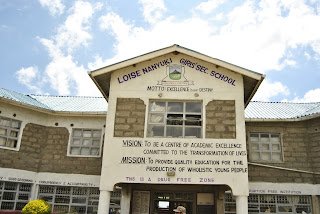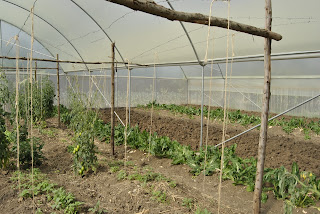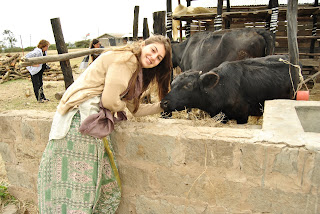3rd August
On the third Richard Vigne gave a couple of
the researchers a lift into Nanyuki, the near by city, to watch Sarah Vigne’s
daughters Ellie and Georgia compete in the annual horseshow there. The
horseshow was unbelievable. Four hours away from Nairobi, in the middle of
absolutely no where, was the most British, organized, show. Tents selling
pottery, and tribal beads, a tent with a restaurant with tea and cakes and
beautiful horses everywhere, it was mind blowing to have such an “English
afternoon” in the middle of Kenya! The two girls cleared house, won nearly all
the trophies, so had a very proud mum!
4th August

The next day, we went on
another rhino patrol and saw some more animals, which was great!
reticulated giraffe


elephant

elephant

Hartebeest and calf
5th August
On the 5th, I spent the day with
PKSS, Project Sister Kenya Schools (http://projectkenyasisterschools.com)
which is a fantastic organization that works through Ol Pejeta to support
schools in surrounding communities, linking them to schools in Canada and the
US. As I am writing an article for Fauna and Flora international on the
community outreach programme here, it seemed like a good opportunity to go and
see some of the schools for myself.

So the first school we went to was Thome
boys, one that PKSS bought a cow for. Many schools are now starting to use cows
for the energy they need to run the school. The cows are kept in stables, and
their manure is collected and put into a cement hole, it then ferments
underground, and methane is produced, which is then pressurized and can be
connected to pipes to use it for gas stoves. The rest of the fermented waste
becomes slurry, and can be used as a fertilizer. The cows are also of course a
source of milk for the children. Unfortunately the cows had not yet produced
enough dung to start producing methane, so it isn’t running yet, but there are
high hopes for the future. To the left is a picture of where the slurry will eventually come out, and below is where the methane will be piped out of.

Lucy, the cow bought by PKSS for Thome boy's school
The next stop was Malek school, which holds
200 students. The subjects the study cover pretty much what every school does,
with the edition of Swahili. Leigh runs the PKSS link to her school in the
States, and has started a project called “my dreams is to…” where each student,
both in the states and at Malek get a slab of chalkboard with the words “My
dream is to…” and they add on what their dream is, Leigh takes a photo and will
collaborate it all into a slide show. Interestingly nearly all of the Kenyan
children’s dreams were related to jobs involved in medicine, law and dentistry,
while many of the Americans’ dreams were centered around being famous and being
rich.

The girls performing a traditional dance

We then went to Loise’s girls boarding
school for high achieving girls, whose relationship with a Canadian school is managed by Betty. PKSS has donated cows through Ol Pejeta, and now the school uses
the methane to boil water daily.

The headmistress of the school, Esther was
awarded “best headmistress of the year award” for all of Kenya, which was
amazing. The 288 girls boarding there excel in sciences and games especially.
The girls get up at 4.30 each morning to start chores, which involve washing, taking
care of the cows and gardening in their greenhouse, which provides 60% of the
vegetables that the school uses every day, it was a really impressive school
with a very strong work ethic.

At both Malek and Loise’s the girls had
prepared a small show for us, where they performed some local dances, which was
great, they then wanted to learn some western dance moves, which Leigh was more
then happy to teach them.

A water tank donated by Ol Pejeta

Fully functioning slurry at Loise's

Greenhouse at Loise's-you can see spinach and tomatoes
6th August

Beautiful view of mount Kenya

On the 6
th, I did boma
monitoring. Ol Pejeta is becoming a model for conservancy, in the surrounding areas, as it manages to
rear livestock among wildlife, to increase profitability per acre, but also as
a grassland regeneration tool. The cattle graze within a boma, a big lion proof
wooden enclosure, and then are moved to a new area. The place where the old boma
stood often regenerates different grasses, as the intense grazing changes the
soil, this new grass is often more nutritious, which is why bomas are used to
regenerate areas.
We looked at the difference between the area the
boma was in, and that just outside, by splitting it all into three transects,
so the circle of grass where the boma once stood is split into three lines and
different tests are done down those lines. For example, every shrub’s height
within 3 metres either side of the transect is measured, and the same is done
outside the area the boma stood in. Quadrats are also mapped-that is squares of
land, 10m by 10m in this case, and the height of the grasses was measured, as
well as all the different species within the quardrat. The results showed that
there were far fewer shrubs within the boma area, and fewer species of grass,
however these were more nutritious types. The picture to the right shows one of the ways to measure species diversity, the needles on the grid are dropped, and you identify the different grass species it touches.
I also had to identify and count all the different types of dung in an area, to see how the range of animals changed within the old boma site and outside. In fact they did, the only dung we found outside the site was zebra, while within it we found many different types

Elephant dung.

Buffaolo dung

Eland dung

Warthog dung

Zebra dung

Giraffe dung

Thompson's (the smaller ones) and Grant's gazelle dung

Arranged by order of size

I also found out a little about the
mutualistic relationship between the whistling thorn (
Acacia drepanolobium) and ants. The tree is an acacia, that
produces thorns as well as leaves, and on the branches are bulbous thorns,
which are hollow. Ant species make entry holes in these bulbs, which whistle
when the wind blows through, hence the name. The ants receive shelter in the
trees, and in return defend the tree against herbivores like black rhinos and
giraffe, by stinging them.

Male ostrich

Last night Rishi and I were invited
to Sarah and Richards for lunch, and we ended up staying for supper and the
night! They have a beautiful house about 40 minutes from control, so we drove
there, and on the way were lucky enough to see a pride of lions and wild dog!
All in all a very interesting few days!!
 Today, I joined the PKSS group once again to visit a school, the last day I could have as they are all closing for summer. We were visiting Uasonyiro primary school, on the northern boundaries of the park.
Today, I joined the PKSS group once again to visit a school, the last day I could have as they are all closing for summer. We were visiting Uasonyiro primary school, on the northern boundaries of the park. On the way we stopped by a house that the PKSS group have donated money to help fix, originally the repair was going to be on one of the walls, however they ended up rebuilding the house as it was going to collapse. They didn't actually choose the woman to donate the money to, rather the community itself decided who was in the most need. Doing it in this fashion prevents jealousy within the community, as they have chosen, rather than outsiders just coming in and giving. What was really interesting about visiting was learning a little about land ownership in Kenya. So one can either own land privately, as in buy it, or the government owns it, and it is communal. So Maasai and Samburu tribes tend to live north of Ol Pejeta, and they are pastoralists rather than farmers, so they don't stay in specific areas for their whole lives but drift between lands. Usually the pastoralists just live on the communal lands, not owning it, but the problem is that the government can decide that it needs the land for something-a conservancy or a ranch for example, it can take it, which can make for very unstable living situations.
On the way we stopped by a house that the PKSS group have donated money to help fix, originally the repair was going to be on one of the walls, however they ended up rebuilding the house as it was going to collapse. They didn't actually choose the woman to donate the money to, rather the community itself decided who was in the most need. Doing it in this fashion prevents jealousy within the community, as they have chosen, rather than outsiders just coming in and giving. What was really interesting about visiting was learning a little about land ownership in Kenya. So one can either own land privately, as in buy it, or the government owns it, and it is communal. So Maasai and Samburu tribes tend to live north of Ol Pejeta, and they are pastoralists rather than farmers, so they don't stay in specific areas for their whole lives but drift between lands. Usually the pastoralists just live on the communal lands, not owning it, but the problem is that the government can decide that it needs the land for something-a conservancy or a ranch for example, it can take it, which can make for very unstable living situations. which involves filming the kids preparing their lunch, and showing what they eat, in both Kenya and Canada and swap the films so that the children either side can see what the others eat. The definite highlight was when the kids all performed tribal dances, which I got involved in, it was absolutely breathtaking; the colours and beads, beats and musicality, all of it!
which involves filming the kids preparing their lunch, and showing what they eat, in both Kenya and Canada and swap the films so that the children either side can see what the others eat. The definite highlight was when the kids all performed tribal dances, which I got involved in, it was absolutely breathtaking; the colours and beads, beats and musicality, all of it!






















































